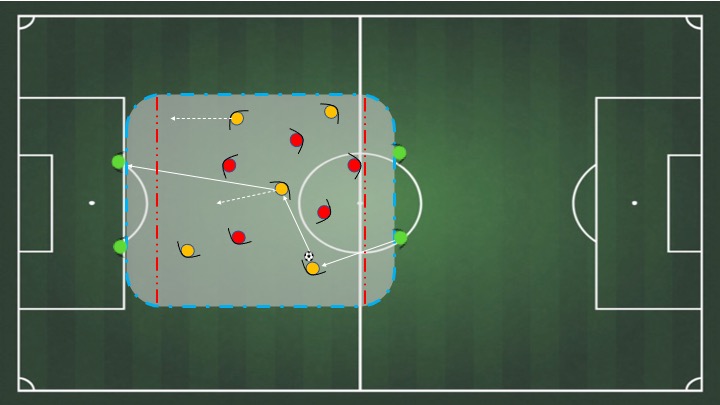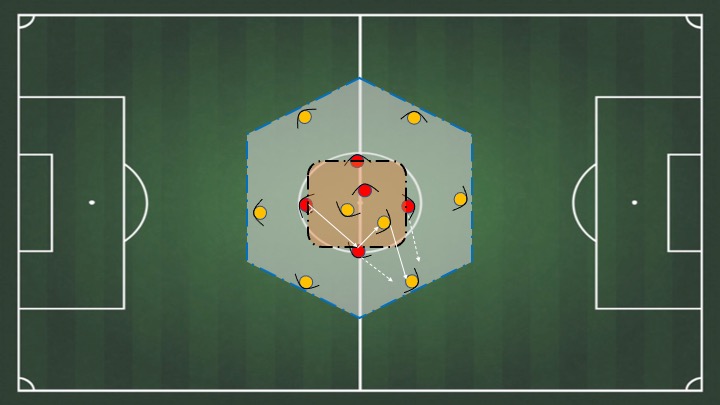Possession Games to Train Ball Control
Possession Games have gain a lot of attention the last few years as a way to train football teams. Why? Because it develops the team’s ball control. Ball control is a critical skill in football that can make all the difference on the pitch.
Teams that can maintain possession of the ball for longer periods of time have a better chance of creating scoring opportunities and dominating their opponents. In this article, we will discuss five simple possession games that coaches can use to help their team improve their ball control and ultimately their performance.
Table of Contents
The Importance of Ball Control:
In order to control the ball during a football match, one needs a set of essential abilities that includes physical might, technical talent, and tactical awareness. Players who are at ease and confident with the ball in their hands are more likely to make the right judgments under pressure and have the capacity to keep the ball for longer.
Ball control can enhance players’ confidence and morale in addition to enhancing performance on the field. With the ball in their hands, players are more willing to take risks and execute inventive plays, which may create exciting moments and improve team spirit.
Training Possession Games:
Soccer possession drills are one of the best ways to improve ball control. These games are made to give players an engaging and fun approach to improve their passing, receiving, and moving off the ball skills. Except the technical skills, other individual tactical and mental skills such as spatial awareness, decision-making, and teamwork can also be improved by playing different types of possession games.
Players can become better at controlling the tempo of the game, understanding when to pass and when to dribble, and maintaining possession under pressure. This is feasible because by using possession games, the team is train in a game-realistic environment.
Furthermore, possession games can be tailored to the specific needs and goals of your team. Coaches can modify the size of the playing area, the number of players, and the rules of the game to create a training session that is both challenging and enjoyable for their players.
You are looking for more possession games ideas?
If you’re a coach looking to take your team’s performance to the next level, then you’ll want to check out “PEP GUARDIOLA – 85 PASSING, RONDOS, POSSESSION GAMES & TECHNICAL CIRCUITS DIRECT FROM PEP’S TRAINING SESSIONS“
My 5 Favourite types of Possession Games
7 v 7 + 3 neutrals Possession Game with 5 gates

Description
2 Teams of 7 players and 3 neutrals (one on each side and one inside). The team in possession must keep the ball and try to score in the small gates by passing to a teammate who is on the other side. To count the goal the player who receives the pass must control it (not just touching it). The defending team tries to recover the ball and switch roles.
Rules
- If a team scores in one gate, they must switch area to score to another gate
Progression
- Limit the touches to make it more difficult
- Put the neutral players inside. This will remove the safe pass to a player outside the pitch (more difficult)
- Reduce the number of neutrals (more difficult)
Objectives
- Switch play
- Fast ball circulation
- Offer constantly support – emergency support to the ball carrier
8 v 8 Possession Game with Transitions

Description
2 Teams of 8 players. The team in possession must keep the ball and complete 10 passes to score a goal. The defending team tries to recover the ball, quickly switch side (representing the attacking transition) and move to the other box. The team who lose the possession must quickly react to recover the ball (defensive transition). If the ball is transfered to the other side, 6 players follows to press.
Rules
- If the team who lose the ball manage to recover the ball before the switch +1 goal
Progression
- Limit the touches to make it (more difficult)
- Add 1 neutral to increase the possession time of a team (more easy)
- Reduce the number of passes for a goal (more demanding and intensive – suitable for fitness purposes)
Objectives
- Fast change mentality from attack to defense and vice versa
- Counter-attack and counter-pressing principles
- Prioritise the “Not Switch” and then the “Ball recover“
5 v 5 + 4 neutrals directional Possession Game

Description
The team in possession must keep the ball and transfer it from one side neutrals too the other side to score a goal. The defending team must recover the ball and switch roles.
Rules
- The neutrals on the same side can exchange only one pass between them and then they have to pass inside (represent and ball circulation among central defenders)
- Defenders can enter in the two end zones ONLY when the ball is to the neutrals to press them. This will force the defenders to push up to press and not staying in front of the neutrals to protect a pass to them
Progression
- Limit the touches (more difficult)
- Add additional goals for a number of passes completion. This will force the defenders to run to recover the ball and not just protecting the pass to the other side neutrals (more demanding and intensive – suitable for fitness purposes)
Objectives
- Prioritise forward ball progression
- Identify when to pass or drive forward
- Add additional goals for a number of passes completion. This will force the defenders to run to recover the ball and not just protecting the pass to the other side neutrals (more demanding and intensive – suitable for fitness purposes)
8 v 5 Possession Game with transitions

Description
The possession drill starts with a 5 v 2 in the central box. A goal is scored for every 6 passes. The defending team must recover the ball and play to the outside teammates to switch roles and become the team in possession. They also can score a goal for every 6 passes. If the new defending team recovers the ball they have to kick t outside the area. A new ball s served to the central box.
Rules
- The team in possession that starts the game has 2 touches
- The 2 yellow inside defenders when they recover the ball and become attackers they should remain inside the box
Progression
- Start the inside possession – Red team – with one touch (more difficult). This will ensure lots of lose balls and transitions
- Instead of kicking the ball out of the pitch, the team that recovers the ball n the big space (yellow) can score in small gates that are located outside the space to the sides
Objectives
- Fast change mentality from attack to defense and vice versa
- Counter-attack and counter-pressing principles
- Aggressive pressing
8 v 7 + 1 neutral Possession Game with Attacking transition

Description
The game starts with the Red team in possession. Their target is to pass the ball to the green neutral to score a goal. The yellow defending team must recover the ball and go for a fast counter attack. The options are:
- Pass the ball to the wingers and go for a 3 v 2
- Pass the ball to the center forward for a lay off pass and then run forward
- Pass the ball directly to the space behind the center backs for the center forward
Rules
- The red team starting in possession has two touches
- The yellow team after recovering the ball has 8 seconds to finish the action
Progression
- Allow on red and one yellow midfielders from the central area to flow the action in the box representing defender’s recovering and attacking midfielders pushing in the box
Objectives
- Fast change mentality from defense to attack and vice versa
- Counter-attack principles
- Willing to run forward and enter the box for a goal
Conclusion
In conclusion, possession games are a crucial tool for coaches to develop their team’s ball control and ultimately their performance on the pitch. By incorporating these simple yet effective exercises into your training regimen, your players can improve their passing, receiving, and movement off the ball skills, as well as their spatial awareness, decision-making, and teamwork skills.
Remember to tailor the drills to your team’s specific needs and goals, and to make the training sessions fun and engaging. With dedication and practice, your team will be well on their way to mastering possession and dominating the game.

